
Catalog excerpts
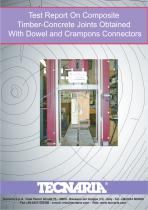
Test Report On Composite Timber-Concrete Joints Obtained With Dowel and Crampons Connectors ¨ Tecnaria S.p.A. Viale Pecori Giraldi 55 - 36061- Bassano del Grappa (VI) - Italy - Tel. +39.0424 502029 Fax +39.0424 502386 - e-mail: info@tecnaria.com - Web: www.tecnaria.com
Open the catalog to page 1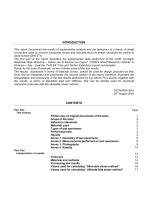
INTRODUCTION This report documents the results of experimental analysis into the behaviour of a family of dowel connectors used to connect composite timber and concrete floors to timber structures by means of wood screws (DIN 571). The first part of the report describes the experimental tests performed at the “CNR Consiglio Nazionale delle Ricerche – Istituto per la Ricerca sul Legno” [“CNR's Wood Research Institute” in Florence – Italy - (now the “IVALSA” Tree and Timber Institute)] on push-out samples. Purely for the sake of example, annex 4 shows some of the test results. The results,...
Open the catalog to page 2
CONSIGLIO NAZIONALE DELLE RICERCHE CONSIGLIO NAZIONAL E DELLE RI CERCHE Istituto per la Ricerca sul Legno Isti tu to per la Ricerca sul Legno Relazione sulle prove eseguite su giunti misti legno-calcestruzzo realizzati con connettori tipo “Tecnaria connettore Base” e “Tecnaria connettore Maxi” I 50 provini di abete/pino sono stati assem 1. Scopo delle prove Determinazione del comportamento meccanico a taglio puro e rilevazione delle curve carico-deformazione su giunti per strutture miste legno-calcestruzzo realizzati con connettori tipo “Tecnaria connettore base” e “Tecnaria connettore...
Open the catalog to page 3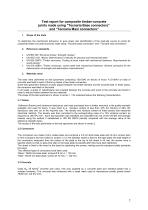
Test report for composite timber-concrete joints made using “Tecnaria Base connectors” and “Tecnaria Maxi connectors” 1. To determine the mechanical behaviour to pure shear and identification of the load-slip curves on joints for composite timber-concrete structures made using “Tecnaria base connectors” and “Tecnaria maxi connectors”. 2. Reference standards UNI EN 338 “Structural timber. Strength classes” UNI ISO 3131 “Wood. Determination of density for physical and mechanical tests” UNI EN 28970 “Timber structures. Testing of joints made with mechanical fasteners. Requirements for wood...
Open the catalog to page 4
Types of test specimens The 50 test specimens in fir/pine were assembled in 10 different ways as shown in table 1. Table 1 – Number of test specimens for each type (fir/pine). UNI EN 338 strength class BASE connector MAXI connector No board Board 2 cm Board 4 cm No board Board 2 cm Board 4 cm The 30 test specimens in deciduous oak were assembled in 10 different ways as shown in table 2. Table 2 – Number of test specimens for each type (deciduous oak). UNI EN 338 strength class BASE connector MAXI connector No board Board 2 cm Board 4 cm No board Board 2 cm Board 4 cm For test specimens with...
Open the catalog to page 5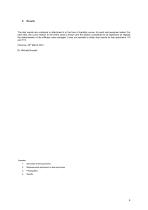
The test results are contained in attachment 4 in the form of load/slip curves, for each test specimen tested. For each test, the curve relative to the entire cycle is shown and the section considered to be significant as regards the determination of the stiffness value enlarged. It was not possible to obtain test results for test specimens 110 and 115. Florence, 26th March 2001 Dr. Michele Brunetti Geometry of test specimens Measurements performed on test specimens
Open the catalog to page 6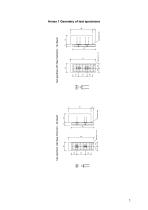
Annex 1 Geometry of test specimens
Open the catalog to page 7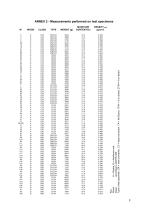
ANNEX 2 - Measurements performed on test specimens WOOD MOISTURE CONTENT(%) CN1TAV CN1TAV CN1TAV CN1TAV CN1TAV CN2TAV CN2TAV CN2TAV CN2TAV CN2TAV CNTA CNTA CNTA CNTA CNTA CNTA CNTA CNTA CNTA CNTA CNTA CNTA CNTA CNTA CNTA CV1TAV CV1TAV CV1TAV CV1TAV CV1TAV CV2TAV CV2TAV CV2TAV CV2TAV CV2TAV CVTA CVTA CVTA CVTA CVTA CVTA CVTA CVTA CVTA CVTA CVTA CVTA CVTA CVTA CVTA CN1TAV CN1TAV CN1TAV CN2TAV CN2TAV CN2TAV CNTA CNTA CNTA CNTA CNTA CNTA CNTA CNTA CNTA CV1TAV CV1TAV CV1TAV CV2TAV CV2TAV CV2TAV CVTA CVTA CVTA CVTA CVTA CVTA CVTA CVTA CVTA Key Wood: A = fir/pine; Q = deciduous oak; Class:...
Open the catalog to page 10
Photo 1: Detail of the formwork, connectors and reinforcing mesh Photo 3 Configuration of test specimen after the test Photo 2: Casting the concrete Photo 4 Detail of linear transducer for slip measurements Photo 5 Slip of connectors after testing
Open the catalog to page 11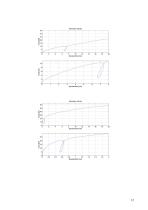
PROVIMO TECSO
Open the catalog to page 13
Studio Tecnico Associato Ing. Maurizio Follesa - Ing. Marco Pio Lauriola EXPERIMENTAL TESTS ON TIMBER-CONCRETE TEST SPECIMENS MADE WITH “BASE” AND “MAXI” CONNECTORS PRODUCED BY “TECNARIA” Interpretation of the results of the tests performed at the CNR Wood Research Institute of Florence Customer: TECNARIA Spa Viale Pecori Giraldi n° 55 - 36061 Bassano del Grappa (VI) Test design and consulting: LegnoDOC Srl via M. De Bernardi n° 64 – 50145 Firenze August 2003 Firenze, via Pistoiese n°171 – 50145 - tel/fax +39.055 315954 – www.timberengineering.it
Open the catalog to page 15
Studio Tecnico Associato Ing. Maurizio Follesa - Ing. Marco Pio Lauriola Foreword The technique of stiffening wooden floors by installing a collaborating concrete slab requires suitable connection systems to be used in order to transfer shear stress between the concrete slab and the timber structure. The connectors counteract the slip between the two materials with their strength and stiffness; as the latter is not infinite, in timber-concrete composite floors slip is limited but nevertheless present. Such slip have to be considered when correctly calculating composite floors and therefore...
Open the catalog to page 16
Studio Tecnico Associato Ing. Maurizio Follesa - Ing. Marco Pio Lauriola Processing test results The test results were provided by the CNR Wood Research Institute of Florence in the terms of load-slip curves. The ultimate load Fmax, e.g. the maximum load reached within a slip of 15 mm, as defined by UNI EN 26891, was determined for each test. Fmax values were reduced with reference to the characteristic density of the class according to the following formula (UNI EN 28970): where: is the ultimate load referred to the characteristic density; Fcor ρk is the characteristic density of the...
Open the catalog to page 17

